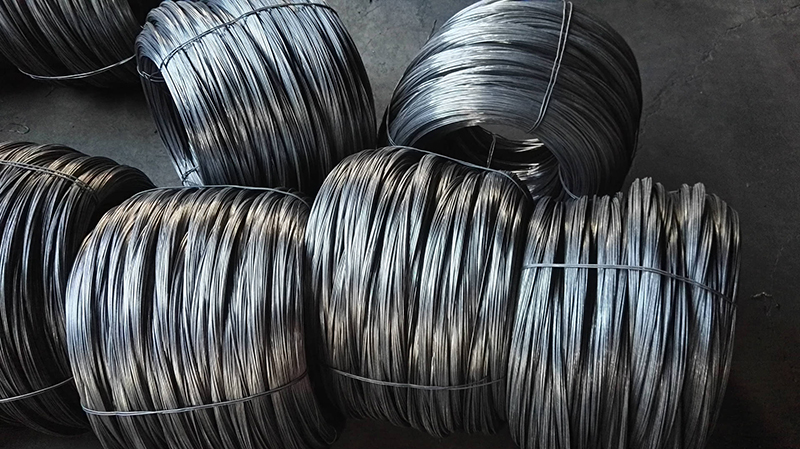Galvanized Iron Wire: Manufacturing, Types, Applications, and Maintenance
Galvanized iron wire, a versatile and durable material, has become indispensable in numerous industries due to its enhanced resistance to corrosion and long service life. This article delves into the key aspects of galvanized iron wire, including its manufacturing processes, common types, wide-ranging applications, and essential maintenance practices, providing a comprehensive guide for professionals and enthusiasts alike.
1. Manufacturing Processes of Galvanized Iron Wire
The core advantage of galvanized iron wire lies in its zinc coating, which acts as a protective barrier against rust and environmental damage. There are two primary methods for applying this zinc coating: hot-dip galvanizing and electrogalvanizing, each with distinct procedures and characteristics.
1.1 Hot-Dip Galvanizing
Hot-dip galvanizing is the most widely used and cost-effective method for producing galvanized iron wire, especially for applications requiring high corrosion resistance. The process begins with wire preparation: raw iron wire is first cleaned to remove surface impurities such as rust, oil, and scale. This cleaning typically involves 酸洗 (using hydrochloric or sulfuric acid) to dissolve oxides, followed by rinsing in water and a flux bath (usually zinc ammonium chloride) to prevent re-oxidation and ensure proper adhesion of the zinc coating.
After preparation, the iron wire is immersed in a molten zinc bath heated to approximately 445–465°C (833–869°F). During immersion, a series of metallurgical reactions occur: the iron in the wire reacts with the molten zinc to form three intermetallic layers (iron-zinc alloys) between the base iron and the outer zinc layer. Once removed from the bath, the wire is cooled (either by air or water) to solidify the zinc coating, resulting in a thick, uniform layer that ranges from 60 to 150 micrometers in thickness. The hot-dip process produces a coating with excellent adhesion and durability, making it suitable for outdoor and harsh-environment applications.
1.2 Electrogalvanizing (Cold Galvanizing)
Electrogalvanizing, also known as cold galvanizing, is an electrolytic process that deposits a thin layer of zinc onto the iron wire surface. Unlike hot-dip galvanizing, this method operates at room temperature, eliminating the need for high-heat treatment. The process starts with similar wire cleaning steps (acid pickling and rinsing) to ensure a clean surface. The cleaned wire is then immersed in an electrolyte solution containing zinc salts (such as zinc sulfate or zinc chloride) and connected to the cathode of a direct current (DC) power supply. A zinc anode is also placed in the solution, and when an electric current is applied, zinc ions from the anode and solution are deposited onto the wire’s surface, forming a thin, smooth zinc coating.
The electrogalvanized coating is typically much thinner than the hot-dip coating, ranging from 5 to 30 micrometers. While it offers good corrosion resistance for indoor or mild-environment use, it is less durable than hot-dip galvanizing in harsh conditions (e.g., heavy rain, saltwater, or industrial chemicals). However, electrogalvanizing provides a more aesthetically pleasing finish with a bright, uniform appearance, making it ideal for applications where visual appeal matters.
2. Common Types of Galvanized Iron Wire
Galvanized iron wire is available in various types, each designed to meet specific application requirements. The classification is often based on factors such as wire diameter, tensile strength, surface finish, and intended use. Below are the most common types:
2.1 Annealed Galvanized Wire
Annealed galvanized wire undergoes a heat treatment process (annealing) after galvanizing to reduce its hardness and increase flexibility. The annealing process involves heating the galvanized wire to a specific temperature (usually 600–800°C) and then cooling it slowly, which relieves internal stresses and makes the wire more ductile. This type of wire is easy to bend, twist, or cut without breaking, making it suitable for applications such as tying plants in agriculture, securing packages in logistics, and crafting (e.g., wire art, jewelry making). It is available in diameters ranging from 0.5 mm to 4 mm, with tensile strength typically between 300–500 MPa.
2.2 High-Tensile Galvanized Wire
High-tensile galvanized wire is engineered to withstand high levels of stress and load, making it ideal for structural and heavy-duty applications. This type of wire is manufactured using high-quality low-carbon steel (with carbon content between 0.15–0.25%) and undergoes a rigorous drawing process to enhance its tensile strength. After galvanizing (either by hot-dip or electrogalvanizing), it exhibits a tensile strength ranging from 600–1200 MPa, significantly higher than that of annealed galvanized wire. High-tensile galvanized wire is commonly used in fencing (e.g., farm fencing, security fencing), construction (e.g., reinforcing concrete, suspending cables), and mining (e.g., supporting underground structures). Its diameter typically ranges from 2 mm to 12 mm, and it is resistant to stretching and deformation under heavy loads.
2.3 Galvanized Wire Mesh
Galvanized wire mesh is a product made by weaving or welding galvanized iron wires into a grid pattern. It is classified based on mesh size (the distance between adjacent wires), wire diameter, and weaving/welding method. Woven galvanized mesh is produced by interlacing wires in a crisscross pattern (e.g., plain weave, twill weave), while welded galvanized mesh is made by welding the intersections of straight wires to form a rigid grid. Galvanized wire mesh offers excellent corrosion resistance and structural stability, making it suitable for a wide range of applications, including window screens (to prevent insects), animal enclosures (e.g., chicken coops, rabbit hutches), construction (e.g., plastering mesh to reinforce walls), and filtration (e.g., separating solids from liquids in industrial processes). The mesh size can vary from 0.5 mm (for fine filtration) to 50 mm (for large animal enclosures), depending on the intended use.
3. Applications of Galvanized Iron Wire
The versatility and durability of galvanized iron wire make it a preferred choice in multiple industries. From agriculture to construction, its applications are diverse and essential to daily operations. Below are the key application areas:
3.1 Agriculture and Horticulture
In agriculture, galvanized iron wire plays a crucial role in crop cultivation and livestock management. Annealed galvanized wire is widely used for tying plants (e.g., tomatoes, grapes) to support structures, as it is flexible and does not damage plant stems. High-tensile galvanized wire is used to build farm fencing, which encloses livestock (cattle, sheep, goats) and protects crops from wildlife. Galvanized wire mesh is also used in greenhouses to create shelves for potted plants and as a barrier to prevent pests from entering. Additionally, galvanized wire is used to make bird nets, which protect fruits (e.g., apples, cherries) from bird damage during ripening.
3.2 Construction and Infrastructure
The construction industry relies heavily on galvanized iron wire for its strength and corrosion resistance. High-tensile galvanized wire is used as reinforcement in concrete structures (e.g., beams, columns, bridges) to enhance their load-bearing capacity and prevent cracking. It is also used in the construction of scaffolding, where it secures metal pipes and planks to ensure worker safety. Galvanized wire mesh is used in plastering and rendering to reinforce walls, reducing the risk of cracking due to temperature changes or structural movement. In infrastructure projects, galvanized wire is used to build gabions (wire mesh cages filled with stones), which are used for erosion control along rivers, coastlines, and highways.
3.3 Logistics and Packaging
In logistics and packaging, galvanized iron wire is used to secure packages, pallets, and containers during transportation. Annealed galvanized wire is preferred for this purpose because of its flexibility and ease of use; it can be twisted around packages to hold them together, preventing damage from shifting during transit. Galvanized wire is also used to make strapping, which is used to bundle heavy items such as steel coils, lumber, and machinery. Additionally, galvanized wire mesh is used to make storage cages and crates, which are used to transport and store fragile goods (e.g., glassware, electronics) in warehouses.
3.4 Home and Daily Use
Galvanized iron wire has numerous applications in households and daily life. It is used to make clotheslines, which are durable and resistant to rust even when exposed to outdoor elements. Galvanized wire mesh is used as window screens and door screens to keep insects out while allowing air circulation. It is also used to make pet cages (e.g., for hamsters, guinea pigs) and garden trellises (for climbing plants such as beans and roses). Additionally, annealed galvanized wire is used in DIY projects, such as making wire baskets, plant hangers, and decorative items.
4. Maintenance and Care of Galvanized Iron Wire
To maximize the service life of galvanized iron wire and ensure its performance, proper maintenance and care are essential. The following practices can help prevent corrosion and damage:
4.1 Regular Inspection
Regular inspection is crucial to detect early signs of corrosion or damage. For outdoor applications (e.g., fencing, gabions), inspect the wire at least once every six months. Look for signs of zinc coating degradation, such as white rust (a powdery zinc oxide layer) or red rust (iron oxide, indicating the zinc coating has been breached). For indoor applications (e.g., wire mesh shelves, clotheslines), inspect the wire annually. If any damage or corrosion is found, take immediate action to repair or replace the affected sections.
4.2 Cleaning
Cleaning the galvanized iron wire regularly can remove dirt, dust, and other contaminants that can accelerate corrosion. For light dirt buildup, use a soft brush or cloth to wipe the wire surface. For more stubborn dirt or grime, use a mild detergent solution (e.g., dish soap and water) and a soft brush, then rinse thoroughly with clean water and dry with a cloth. Avoid using abrasive cleaners (e.g., steel wool, sandpaper) or strong chemicals (e.g., hydrochloric acid, bleach), as these can scratch or dissolve the zinc coating, exposing the iron wire to corrosion.
4.3 Protection Against Harsh Environments
In harsh environments (e.g., coastal areas with high salt content, industrial areas with chemical fumes), additional protection measures are needed to extend the life of galvanized iron wire. For outdoor fencing or structures, apply a layer of zinc-rich paint or coating every 2–3 years to reinforce the zinc barrier. In areas with heavy rainfall or standing water, ensure proper drainage to prevent water from pooling around the wire, as stagnant water can accelerate corrosion. For galvanized wire mesh used in filtration, clean the mesh regularly to prevent clogging, which can cause pressure buildup and damage the wire.
4.4 Proper Storage
If galvanized iron wire is not in use, store it properly to prevent damage. Store the wire in a dry, well-ventilated area away from direct sunlight and moisture. Avoid storing the wire on the ground; instead, use pallets or shelves to keep it elevated. For coiled wire, ensure the coils are not stacked too high, as excessive weight can cause the wire to deform. Additionally, avoid storing galvanized wire near materials that can cause corrosion, such as salt, chemicals, or wet wood.
Conclusion
Galvanized iron wire is a highly versatile and durable material that plays a vital role in numerous industries and daily life. Its manufacturing processes (hot-dip and electrogalvanizing) produce coatings with varying levels of corrosion resistance and aesthetic appeal, while its different types (annealed, high-tensile, wire mesh) cater to a wide range of applications. From agriculture and construction to logistics and home use, galvanized iron wire offers reliable performance and long service life when properly maintained. By understanding its manufacturing, types, applications, and maintenance practices, users can make informed decisions about selecting and using galvanized iron wire to meet their specific needs.



 Send Email
Send Email